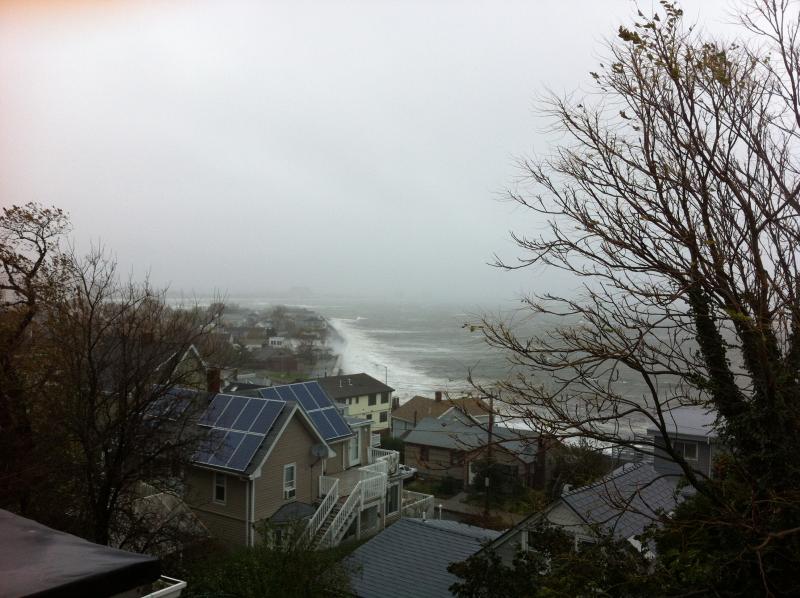Hurricane Sandy Shows A Dramatic Improvement From Botched Katrina Response
My house sits atop a hill overlooking the Atlantic Ocean (hence, the neighborhood name of “Beachmont”) and was built sometime in 1890. It’s one of the tallest houses in the neighborhood and as I write this post, my house is swaying back and forth from 50 mile an hour winds (I’ve been told it’s meant to sway which is somewhat comforting but not entirely) and from my porch, I can see waves crashing over the sea wall and slamming into my neighbor’s homes below me. Needless to say, I have a vested interest in the emergency response to Hurricane Sandy.

There will be time for more detailed analysis later but here are just some initial observations and thoughts:
- FEMA has come a long way since the incompetent response to Hurricane Katrina.
- The response at the federal, state and local level has been much more proactive than I’ve ever seen it in the past. Many New England and Northeast states began communicating to cities and towns about the seriousness of the storm almost a week in advance, many declared emergencies as early as Saturday, and many insisted on mandatory evacuations for the riskiest areas.
- The overall approach is better safe than sorry, even if worst fears about the storm don’t materialize.
- Utilities, after government officials and the public widely criticized them for the extended power outages after Hurricane Irene in August 2011, have brought in extra crews to more quickly respond to downed power lines and outages in advance of the storm.
- They're also trying to communicate better. As an example, my colleague, Rachel Dines, sent me a link to Nstar's outage map: http://outage.nstar.com/
outage/
- They're also trying to communicate better. As an example, my colleague, Rachel Dines, sent me a link to Nstar's outage map: http://outage.nstar.com/
- Private organizations took advantage of their remote access capabilities to proactively close offices on Monday and encourage employees to work from home.
- However, many organizations are realizing that their VPNs can’t handle the vast number of people up and down the East Coast that suddenly need to work from home at once.
- In addition, companies are also finding that remote access strategies are only as good as the local infrastructure where their employees live. Many in urban Boston are reporting that cell towers are overloaded and there is limited bandwidth for quality IP softphone calls, so unless you’ve got an old school landline, communication is a little bit harder. And of course, if there are power outages, your employees won’t be working much at all.
- It’s not clear just yet how well private organizations communicated to their customers about service expectations during the storm.
- Everyone, including government officials, utilities, schools and private organizations are taking advantage of multiple modes of communication (TV, radio, Twitter, mobile apps etc.) to communicate as much information as possible throughout the storm.
- I always encourage everyone to follow FEMA on Twitter (@fema and @femaregion1 if you live New England and @femaregion2 if you leave in NY/NJ) for storm news, tips and tricks. I also follow the Massachusetts Emergency Management Agency (@MassEMA).
- My local community uses an emergency notification service (with a supported mobile application) called CodeRED. I’ve only received one notification so far even though the storm is raging outside and I know my town has blocked off several streets, but they’re trying….You should make sure that you’re signed up for community alerts as well.
- Most airlines waived the change fee for customers who want to reschedule flights to the Northeast. I’d say this was a noble gesture if I wasn’t so annoyed that airlines now charge you just to take a deep breath on the plane (ok, that’s perhaps a bit harsh, I travel a lot and I’m venting unrelated frustrations. I apologize).
I spend a lot of time focusing on communication in this post because over and over again, emergency and business continuity professionals tell us that it’s the part of contingency planning that people don’t appreciate enough. Clear, concise and useful communication is difficult enough for most governments, private organizations and nonprofits – now try doing it under duress.
That’s why in this year’s joint Forrester Research and Disaster Recovery Journal survey, we’re focusing on the interplay of business continuity, risk management and crisis communication. As you think about your organization’s response to Hurricane Sandy, you can help us and the broader industry learn from this event by taking our joint survey here.
I’m interested to hear your reaction to Hurricane Sandy preparations and if you have any lessons learned, we’d love to hear from you.
